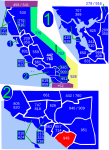2022 Laguna Woods shooting
2020s crimes in California2022 in California2022 mass shootings in the United States21st century in Orange County, CaliforniaAsian-American-related controversies ... and 12 more
Attacks on buildings and structures in 2022Attacks on buildings and structures in CaliforniaAttacks on churches in North AmericaAttacks on religious buildings and structures in the United StatesDeaths by firearm in CaliforniaHate crimesMass shootings in CaliforniaMass shootings in the United StatesMay 2022 crimes in the United StatesPolitical violence in the United StatesUse American English from May 2022Use mdy dates from May 2022
The Laguna Woods shooting was a mass shooting that occurred on May 15, 2022, at the Geneva Presbyterian Church in Laguna Woods, California, United States. The church in Orange County was hosting a congregation of the Irvine Taiwanese Presbyterian Church for Sunday services. The shooter killed one person and wounded five others. A suspect, 68-year-old David Chou of Las Vegas, was arrested at the scene. Authorities allege that the crime was committed out of a political hatred of Taiwan and the Taiwanese people. Chou has been charged with one count of murder and five counts of attempted murder, all with hate crime enhancements, and four counts of possessing an explosive device.
Excerpt from the Wikipedia article 2022 Laguna Woods shooting (License: CC BY-SA 3.0, Authors).2022 Laguna Woods shooting
El Toro Road,
Geographical coordinates (GPS) Address Nearby Places Show on map
Geographical coordinates (GPS)
| Latitude | Longitude |
|---|---|
| N 33.60964 ° | E -117.73338 ° |
Address
Geneva Presbyterian Church
El Toro Road
92637
California, United States
Open on Google Maps







